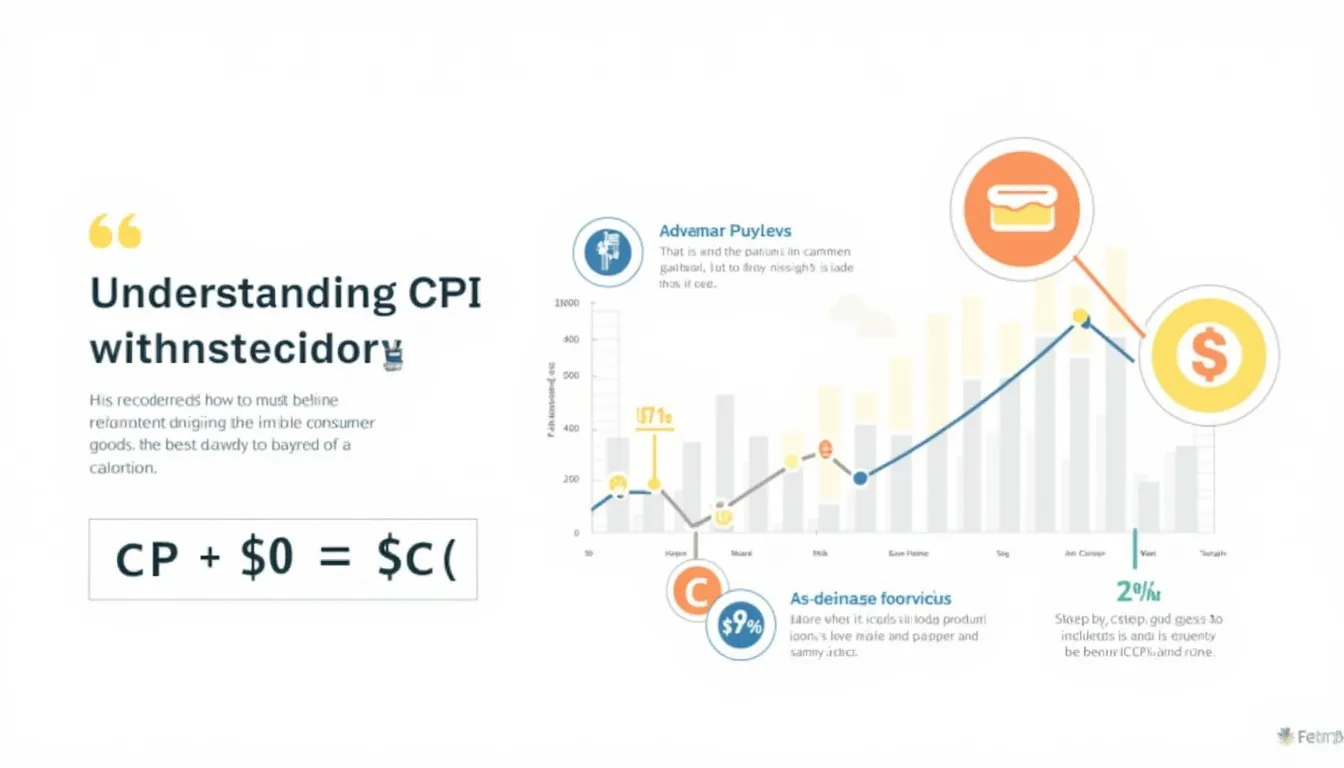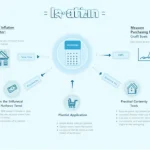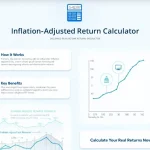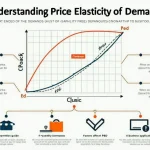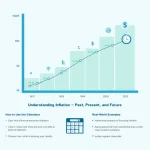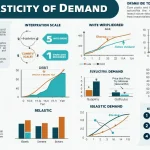CPI Calculator
Is this tool helpful?
How to Use the CPI Calculator Effectively
Step-by-Step Guide to Calculating Consumer Price Index (CPI)
Our CPI Calculator is designed to help you easily compute the Consumer Price Index and understand inflation rates. Follow these steps to use the calculator effectively:
- Enter the Base Year: Input the year you want to use as the reference point for your CPI calculation. For example, enter “2010” if you want to compare prices against that year.
- Specify the Current Year: Input the year for which you want to calculate the CPI. For instance, enter “2023” if you’re comparing current prices to the base year.
- Add Items to Your Market Basket: The calculator starts with one item by default. For each item:
- Enter the item name (e.g., “Bread”)
- Specify the quantity (e.g., “10” for 10 loaves)
- Input the base year price in USD (e.g., “1.00” for $1.00 per loaf in 2010)
- Enter the current year price in USD (e.g., “1.20” for $1.20 per loaf in 2023)
- Add More Items: Click the “Add Another Item” button to include additional goods or services in your market basket. For a comprehensive CPI calculation, consider adding various items such as:
- Milk (e.g., 2 gallons, $3.00 in base year, $3.50 in current year)
- Rent (e.g., 1 month, $1000 in base year, $1200 in current year)
- Gasoline (e.g., 50 gallons, $2.50 in base year, $3.00 in current year)
- Calculate CPI: Once you’ve entered all your items, click the “Calculate CPI” button to generate the results.
Understanding the Results
After calculation, the tool will display:
- Consumer Price Index (CPI): This value shows how prices have changed relative to the base year. A CPI of 110, for example, indicates that prices have increased by 10% since the base year.
- Inflation Rate: This percentage represents the rate of price level increase since the base year.
- Visual Representation: A bar chart comparing the cost of your market basket in the base year versus the current year.
Understanding the Consumer Price Index (CPI) Calculator
What is the Consumer Price Index?
The Consumer Price Index (CPI) is a crucial economic indicator that measures the average change over time in the prices paid by urban consumers for a market basket of consumer goods and services. It’s essentially a tool that helps us understand how the purchasing power of a currency changes over time, reflecting the effects of inflation on consumer spending.
Purpose and Benefits of the CPI Calculator
Our CPI Calculator serves several important purposes:
- Inflation Measurement: It allows users to calculate and visualize inflation rates between two periods.
- Cost of Living Analysis: Users can compare the cost of a specific set of goods and services over time.
- Economic Research: Researchers and students can use it to study price trends and economic patterns.
- Financial Planning: Individuals and businesses can use CPI data to make informed financial decisions and projections.
Key Benefits of Using Our CPI Calculator
- User-Friendly Interface: The calculator’s intuitive design makes it easy for anyone to input data and calculate CPI, regardless of their economic background.
- Customizable Market Basket: Users can add as many items as they want, allowing for a personalized and accurate representation of their consumption patterns.
- Visual Results: The included bar chart provides a clear visual comparison of costs between the base year and current year.
- Instant Calculations: Complex CPI and inflation rate calculations are performed instantly, saving time and reducing the risk of manual calculation errors.
- Educational Tool: It serves as an excellent resource for students and educators to demonstrate the concepts of CPI and inflation in a practical, interactive way.
How the CPI Calculator Addresses User Needs
Solving Specific Economic Problems
Our CPI Calculator addresses several key user needs and solves specific problems related to understanding economic trends:
- Simplifying Complex Calculations: Calculating CPI manually can be time-consuming and error-prone. Our calculator automates this process, ensuring accuracy and saving valuable time.
- Personalizing Inflation Analysis: By allowing users to input their own market basket items, the calculator provides a personalized view of how inflation affects individual consumption patterns.
- Facilitating Historical Comparisons: Users can easily compare prices between any two years, helping them understand long-term economic trends.
- Supporting Decision-Making: The calculated CPI and inflation rates provide valuable insights for financial planning, wage negotiations, and policy-making.
Mathematical Foundation
The CPI Calculator uses the following formulas to compute its results:
$$CPI = \frac{\text{Cost of Market Basket in Current Year}}{\text{Cost of Market Basket in Base Year}} \times 100$$$$\text{Inflation Rate} = \frac{CPI – 100}{100} \times 100\%$$Example Calculation
Let’s walk through an example calculation to illustrate how the CPI Calculator works:
Scenario: Calculating CPI for a simple market basket between 2010 (base year) and 2023 (current year)
Market Basket:
- Bread: 10 loaves
- Milk: 5 gallons
- Eggs: 2 dozen
Prices:
| Item | 2010 Price | 2023 Price |
|---|---|---|
| Bread | $2.00/loaf | $3.50/loaf |
| Milk | $3.00/gallon | $4.50/gallon |
| Eggs | $2.50/dozen | $4.00/dozen |
Calculations:
1. Cost of Market Basket in 2010 (Base Year):
- Bread: 10 × $2.00 = $20.00
- Milk: 5 × $3.00 = $15.00
- Eggs: 2 × $2.50 = $5.00
- Total: $20.00 + $15.00 + $5.00 = $40.00
2. Cost of Market Basket in 2023 (Current Year):
- Bread: 10 × $3.50 = $35.00
- Milk: 5 × $4.50 = $22.50
- Eggs: 2 × $4.00 = $8.00
- Total: $35.00 + $22.50 + $8.00 = $65.50
3. CPI Calculation:
$$CPI = \frac{$65.50}{$40.00} \times 100 = 163.75$$4. Inflation Rate:
$$\text{Inflation Rate} = \frac{163.75 – 100}{100} \times 100\% = 63.75\%$$Interpretation: The CPI of 163.75 indicates that the price level in 2023 is 63.75% higher than it was in 2010 for this specific market basket of goods.
Practical Applications of the CPI Calculator
Real-World Use Cases
The CPI Calculator has numerous practical applications across various fields:
- Personal Financial Planning:
- Adjusting savings goals for inflation
- Estimating future costs of major expenses (e.g., college tuition, retirement)
- Evaluating the real value of investments over time
- Business Strategy:
- Pricing strategies and adjustments
- Cost projections for long-term projects
- Wage and salary negotiations
- Economic Research:
- Analyzing historical price trends
- Comparing cost of living across different time periods
- Studying the effectiveness of monetary policies
- Government Policy:
- Adjusting social security benefits and pensions
- Setting minimum wage levels
- Formulating monetary and fiscal policies
Case Study: Adjusting Rental Prices
Let’s consider a practical example of how a landlord might use the CPI Calculator to adjust rental prices fairly:
Scenario: A landlord wants to adjust the rent for a property based on CPI changes from 2018 to 2023.
Initial Data:
- Base Year: 2018
- Current Year: 2023
- Original Monthly Rent: $1,000
Using the CPI Calculator:
- The landlord inputs various items representing the cost of property maintenance, including:
- Property taxes
- Insurance
- Utilities
- Repair services
- After calculation, the CPI Calculator shows:
- CPI: 115.5
- Inflation Rate: 15.5%
Rent Adjustment Calculation:
$$\text{New Rent} = \text{Original Rent} \times \frac{\text{Current CPI}}{\text{Base CPI}}$$$$\text{New Rent} = $1,000 \times \frac{115.5}{100} = $1,155$$Result: The landlord can justify increasing the rent to $1,155 per month, which accurately reflects the increased costs associated with maintaining the property.
Frequently Asked Questions (FAQ)
1. What is the Consumer Price Index (CPI)?
The Consumer Price Index (CPI) is an economic indicator that measures the average change in prices over time that consumers pay for a basket of goods and services. It’s commonly used to identify periods of inflation or deflation.
2. How often should I use the CPI Calculator?
The frequency of use depends on your needs. For personal financial planning, annual calculations can be helpful. Businesses might use it quarterly, while economists and researchers may use it more frequently for ongoing analysis.
3. Can I use the CPI Calculator for international comparisons?
While our calculator is designed for use with a single currency (USD), the principles can be applied to other currencies. However, for accurate international comparisons, you should use CPI data specific to each country.
4. How many items should I include in my market basket?
The more items you include, the more comprehensive and accurate your CPI calculation will be. Try to include a diverse range of goods and services that represent your typical consumption patterns or the economy you’re analyzing.
5. What’s the difference between CPI and inflation rate?
CPI is a measure of the average price level relative to a base year, while the inflation rate is the percentage change in the CPI over a specific period. Our calculator provides both metrics for a complete understanding of price changes.
6. Can the CPI Calculator predict future prices?
The CPI Calculator is designed to analyze historical data and current trends, not to predict future prices. However, understanding past CPI trends can help inform projections and financial planning.
7. How does the CPI Calculator handle quality improvements in products?
Our basic calculator doesn’t automatically account for quality improvements. When using the tool, you may need to manually adjust for significant quality changes in products over time for more accurate long-term comparisons.
8. Is the CPI calculated by this tool the same as the official CPI?
The CPI calculated by this tool is based on the data you input and may differ from official CPI figures, which are calculated using a much larger and standardized basket of goods and services. Our tool is meant for educational and personal analysis purposes.
9. How can I use the CPI Calculator for budgeting?
You can use the calculator to adjust your budget for inflation. By calculating the CPI for your personal basket of goods and services, you can estimate how much more you might need to budget in the future to maintain your current lifestyle.
10. Can the CPI Calculator be used for deflation scenarios?
Yes, the calculator can handle deflation scenarios. If prices in the current year are lower than in the base year, the CPI will be below 100, and the inflation rate will be negative, indicating deflation.
Conclusion
The Consumer Price Index (CPI) Calculator is an invaluable tool for understanding and quantifying the effects of inflation on our daily lives and the broader economy. By providing a user-friendly interface for complex economic calculations, it empowers individuals, businesses, and researchers to make informed decisions based on accurate price trend data.
Whether you’re adjusting your personal budget, planning business strategies, or conducting economic research, this CPI Calculator offers the flexibility and accuracy needed to navigate the ever-changing landscape of consumer prices. Remember, while the tool provides valuable insights, it’s always important to consider broader economic contexts and consult with financial professionals for major decisions.
We encourage you to explore the CPI Calculator, experiment with different scenarios, and gain a deeper understanding of how price changes affect your financial world. By staying informed about CPI trends, you’ll be better equipped to make sound financial decisions and adapt to the economic environment around you.
Important Disclaimer
The calculations, results, and content provided by our tools are not guaranteed to be accurate, complete, or reliable. Users are responsible for verifying and interpreting the results. Our content and tools may contain errors, biases, or inconsistencies. We reserve the right to save inputs and outputs from our tools for the purposes of error debugging, bias identification, and performance improvement. External companies providing AI models used in our tools may also save and process data in accordance with their own policies. By using our tools, you consent to this data collection and processing. We reserve the right to limit the usage of our tools based on current usability factors. By using our tools, you acknowledge that you have read, understood, and agreed to this disclaimer. You accept the inherent risks and limitations associated with the use of our tools and services.
